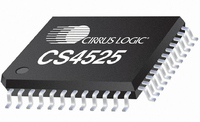CS4525-CNZR Cirrus Logic Inc, CS4525-CNZR Datasheet - Page 26

CS4525-CNZR
Manufacturer Part Number
CS4525-CNZR
Description
IC PWM Controller+power Stage
Manufacturer
Cirrus Logic Inc
Series
Popguard®r
Type
Class Dr
Datasheet
1.CS4525-CNZ.pdf
(98 pages)
Specifications of CS4525-CNZR
Output Type
2-Channel (Stereo) or 4-Channel (Quad)
Max Output Power X Channels @ Load
30W x 1 @ 4 Ohm; 15W x 2 @ 8 Ohm
Voltage - Supply
8 V ~ 18 V
Features
ADC, Depop, I²C, I²S, Mute, PWM, Short-Circuit and Thermal Protection, Volume Control
Mounting Type
Surface Mount
Package / Case
48-QFN
Lead Free Status / RoHS Status
Lead free / RoHS Compliant
For Use With
598-1586 - REFERENCE BOARD FOR CS4525 PWM
Lead Free Status / RoHS Status
Lead free / RoHS Compliant
Available stocks
Company
Part Number
Manufacturer
Quantity
Price
Part Number:
CS4525-CNZR
Manufacturer:
CIRRUSLOGICINC
Quantity:
20 000
26
6. APPLICATIONS
6.1
6.1.1
Software Mode
Maximum device flexibility and features are available when the CS4525 is used in software mode. The avail-
able features are described in the following sections. All device configuration is achieved via the I²C control
port as described in the
6.1.1.1
If an input clock is detected on the SYS_CLK pin following the release of RST, the device will automatically
use the SYS_CLK input as its clock source. The applied SYS_CLK clock signal must oscillate within the
frequency ranges specified in the SYS_CLK switching specifications table on
should be connected to ground and XTO should be left unconnected.
Figure 12
System Clocking
In software mode, the CS4525 can be clocked by a stable external clock source input on the SYS_CLK
pin or by a clock internally generated through the use of its internal oscillator driver circuit in conjunction
with an external crystal oscillator. The device automatically selects which of these clocks to use within
10 ms of the release of RST.
The internal clock is used to synchronize the input serial audio signals with the internal clock domain and
to clock the internal digital processing, sample-rate converter, and PWM modulators. It is also used to de-
termine the sample rate of the serial audio input signals in order to automatically configure the various
internal filter coefficients.
To ensure proper operation, the CS4525 must be informed of the nominal frequency of the supplied
SYS_CLK signal or the attached crystal via the ClkFreq[1:0] bits in the Clock Config register. These bits
must be set to the appropriate value before the PDnAll bit is cleared to initiate a power-up sequence. See
the
input frequency range specifications.
WARNING: The system clock source must never be removed or stopped while any of the power output
stages are powered-up (the PDnAll bit and any of the PDnOut1, PDnOut2, or PDnOut3/4 bits are cleared)
and connected to a load. Doing so may result in permanent damage to the CS4525 and connected trans-
ducers.
Referenced Control
ClkFreq[1:0].........................
PDnAll .................................
PDnOutX .............................
SYS_CLK Switching Specifications
below demonstrates a typical clocking configuration using the SYS_CLK input.
SYS_CLK Input Clock Mode
Clock
Figure 12. Typical SYS_CLK Input Clocking Configuration
I²C Control Port Description and Timing
Register Location
“Clock Frequency (ClkFreq[1:0])” on page 69
“Power Down (PDnAll)” on page 89
“Power Down PWM Power Output X (PDnOutX)” on page 89
Clock_In
DSP
and
Reset_Out
XTI Switching Specifications
RST
section on
SYS_CLK
CS4525
tables on
page
page
64.
XTO
XTI
page 23
23. In this mode, XTI
for complete
CS4525
DS726PP3




















